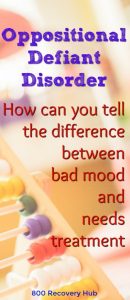Oppositional Defiant Disorder (ODD)
Oppositional Defiant Disorder (ODD) is a behavioral disorder, commonly found in kids and young people. It typically shows a pattern of angry and disobedient behavior. Normally this is directed at parents, teachers, and figures of authority. Kids suffering from ODD argue with adults and have a hard time controlling their behavior.
The most common behaviors are negativity, hostility, defiance, and aggression.
The most frustrating thing for parents is that there is no single test that can diagnose ODD. However, typically, a doctor can figure out if a child has the disorder by looking at their pattern of behavior.
Children with ODD show an ongoing signs of extreme negativity, hostility, and defiance that:
- Last six months or more
- Is consistent
- Disrupts family and school
- Is aimed at adult family members and of figures of authority
- Is extreme when compared to other children
Symptoms that are associated with ODD
- Temper tantrums
- Questioning and not following rules
- Blaming others
- Revenge-seeking
- Purposefully annoying and upsetting others
- Sudden outbursts of anger
- Often touchy and annoyed
Types of Treatment for ODD
Treatment usually consists of a combination of:
- Parent-Management Training Programs and Family Therapy to teach parents and other family members how to manage the child’s behavior. Parents, family members, and other caregivers are taught techniques in positive reinforcement and ways to discipline more effectively.
- Cognitive Problem-Solving Skills Training to reduce inappropriate behaviors by teaching the child positive ways of responding to stressful situations. Children with ODD often only know of negative ways of interpreting and responding to real-life situations. Cognitive problem-solving skills training teaches them how to see situations and respond appropriately.
- Social-Skills Programs and School-Based Programs to teach children and adolescents how to relate more positively to peers and ways to improve their school work. These therapies are most successful when they are conducted in a natural environment, such as at the school or in a social group.
- Medication may be necessary to help control some of the most distressing symptoms of ODD as well as the symptoms of coexisting conditions, such as ADHD, anxiety, and mood disorders. However, medication alone is not a treatment for ODD.
More about Medication
However, medication may be a useful part of a comprehensive treatment plan to help control specific behaviors and to treat coexisting conditions, such as ADHD, anxiety, and mood disorders. Successful treatment of coexisting conditions often makes ODD treatment more effective. For example, a medication used to treat children with ADHD has been shown to lessen behavioral symptoms when ODD and ADHD coexist. When children and adolescents with ODD also have a mood disorder or anxiety, treatment with antidepressants and anti-anxiety medications has been showing to help lessen the behavioral symptoms of ODD. (1)
Oppositional Defiant Disorder Outlook
It was once thought that most children would outgrow ODD by adulthood. We now know this is not always true. While some of the symptoms of ODD can go away over time, and many children outgrow the disorder, some children with ODD will continue to experience the consequences of ODD during their later years.
For those who do not receive treatment, ODD can develop into Conduct Disorder (CD), a more serious behavioral disorder. Of those with CD, almost 40 percent will develop antisocial personality disorder in adulthood.(2)
Early diagnosis and treatment can help these individuals learn how to cope with stressful situations and manage their behavioral symptoms.
Psychotherapy, parent-management training, skills training, and family therapy work. Research shows that children and adolescents respond well to therapy for ODD. In fact, for those who receive treatment, many are symptom-free once therapy has concluded and will go on to lead rewarding and happy lives.
If your child or someone you loves needs help for Oppositional Defiance Disorder, call us now.
Keep in mind, that when you kick the problem down the road, it can turn into other problems. As your child becomes a teenager or young adult, they might turn to drugs and alcohol. At that point, you are dealing with dual-diagnosis. That is a combination of mental issues and addiction.
Mood tips for changing your emotions at any age
Have you ever been in a bad mood that you just can’t shake? Or had a pile of homework but realized you’re not in the mood to get it done? Sometimes we feel at the mercy of our moods — but moods aren’t things that just happen to us. We can influence and change them.
What’s your favorite type of exercise for improving mood?
Being able to choose the mood that’s best suited to a situation is one of the skills of emotional intelligence. Choosing the right mood can help you control whatever situation you’re in.
Mood + Mindset = Success
Moods can influence how well we do in certain situations, but so can something else: our mindset. What’s the difference between a mood and a mindset? Moods are the emotions we feel. A mindset is the thoughts and ideas that go along with that mood.
Mood and mindset go hand in hand because our thoughts can influence our mood. Here’s an example:
Imagine you’re competing in a swim meet this afternoon. Which mood and mindset help you do your best?
- Mood A: Insecure. You keep thinking about how the competition might blow you out of the water and maybe you’re not good enough to be on the team.
- Mood B: Annoyed. You’re thinking about how swimming interferes with your social life.
- Mood C: Pumped up and confident. You’re thinking that if you do your best, there’s a good chance your team can place well.
Of course, you’re likely to do your best with the mood and mindset in option C. But what if you’re feeling A or B and worry that those moods might affect your performance? Luckily, you can change your mood.
How to Choose a Mood
Step 1: Identify your mood. To switch moods, you need to check in with what you’re currently thinking and feeling. That way you can decide if you need to change your mood to one that’s more suited to your situation — or if you’re in the best mood, to begin with.
To identify a mood, stop and think about what you’re feeling and why. Put those feelings into words, like, “Wow, I’m really sad right now” or “I’m feeling really alone.” You can say this silently to yourself, out loud, or to someone else.
Step 2: Accept what you feel. After you name your emotion, show yourself some understanding for feeling the way you do. It’s perfectly OK (and natural!) to feel bored on a rainy Saturday or annoyed about having to study when everyone else is going out. All emotions are acceptable and understandable. But you don’t have to hold on to feeling that way. Notice your mood, then choose to move past it.
Step 3: Identify the mood that’s best for the situation you’re in. If you’re competing in a swim meet, it’s best to be pumped up and confident. If you need to get down to some serious studying, it’s better to feel interested, alert, and confident (and not so helpful to feel grumpy, annoyed, and self-defeated). Take a minute to think about which emotions will help you accomplish your goal.
How to Get Into the Best Mood
After you imagine the mood that’s best suited for your task or situation, it’s time to get into that mood. Think “P for positive” and focus on these 6 things that can help you reset your mood:
- Purpose. Get clear on what you want and need to do. For example, you might want to get your studying done as fast and well as possible so you can go to a party later.
- Place. Put yourself in the right situation — environment influences mood. If you need to study, it’s better to find a table or desk in a quiet room than to go to the coffee shop where you might see friends who distract you.
- People. Who can help you feel the way you need to feel? A focused classmate is a better study companion than a chatty friend. Sometimes, just thinking of a particular person is enough to help you feel confident, inspired, strong, or supported.
- Playlist. Music is one of the most powerful influences on mood because it’s all about communicating and inspiring emotion. Create playlists for the moods that are the most helpful and positive for your life.
- Posture. Move your body into the right mood. For studying, try exercises that help you focus on your physical posture like yoga or t’ai chi. For energy, try a workout that gets your heart rate up. To prepare for sleep, try deep breathing, gentle stretching, or other soothing activities.
- Promotion. Encourage yourself with self-talk. Self-talk is a way of using thoughts to influence your mood. If you’ve ever said to yourself, “OK, let’s get serious for a minute” or “I can do this!” you’ve used self-talk to get into the right mood for a situation. Self-talk doesn’t just create the mindset that supports your mood, it also helps you keep a mood going. That’s why pep talks work so well for athletes.
How to Get Out of an Unhelpful Mood
To get out of a mood that’s unpleasant or unhelpful, think “U for U-turn.” Try these mood changes:
- Undo. Do something to break the train of thought that keeps your old mood going. Distract yourself with a game of Sudoku or simply focus on what’s going on outside your window for a few minutes. Distractions are like rebooting your mind — they create a space between moods.
- Unstick. Change your body posture. If you’re sitting, stand up. Do some jumping jacks. Stretch. Walk around the room. Moving your body changes your mindset and mood.
- Unwind. Sit quietly, breathe gently, and focus on each breath. To keep your mind from wandering back to a mood you’re trying to change, every time you take a breath, say to yourself: “I’m breathing in” and “I’m breathing out.” Focus on feeling calm.
You’ve probably chosen your mood before without even realizing it — many times people choose a mood naturally without thinking about it. But practicing ways to choose your mood intentionally can help you get good at it.
So next time you feel a strong mood, stop and name it. Ask yourself if it’s the ideal mood for what you’re trying to accomplish. Sometimes, even the happiest of moods might not be right for a particular situation (as anyone who’s excited about weekend plans during Friday afternoon classes knows).
1.Connor DF, Glatt SJ, Lopez ID, Jackson D, Melloni RH (2002), Psychopharmacology and aggression: I. A meta-analysis of stimulant effects on overt/covert aggression-related behaviors in ADHD. J Am Acad Child Adolesc Psychiatry 41:253-261.
2.Zoccolillo M, Pickles A, Quinton D, Rutter M (1992), The outcome of conduct disorder. Psychol Med 22:971-986.
Personal Notes On ODD
I know how frustrating it can be when you have a kid with Oppositional Defiance. I remember when I was telling my Mom what was going on in our house, she thought I was lying. It’s not as mean as it sounds. It’s just that what I was saying, didn’t make sense to her.
When she flew out and spent a week with me, she issued the most sincere apology. She said:
[quote style=”boxed”]Not only weren’t you exaggerating, you weren’t ever telling the full extremity of the situation[/quote]
Just knowing that I wasn’t crazy felt so reassuring. So the bottom line – stop beating yourself up! Get some help and talk to caring people who will not judge you or your child.
